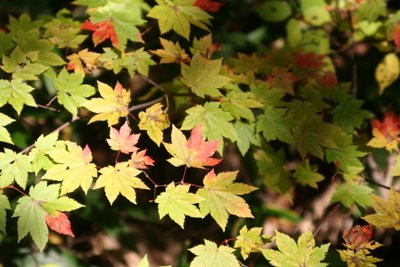Greetings from Japan, where for as polite as they are, they don’t bless people when they sneeze. Also holding a door open for someone is largely not done. Not sure why or why not, but it's just different.
**
If you thought this blog or its author were above potty-talk, guess again. Due to overwhelming pressure, I can no longer remain silent on this topic. (Actually the pressure was only moderately whelming... )
Finally, Japanese restrooms will be addressed! First an image to set the tone (from a train station in Nagoya).
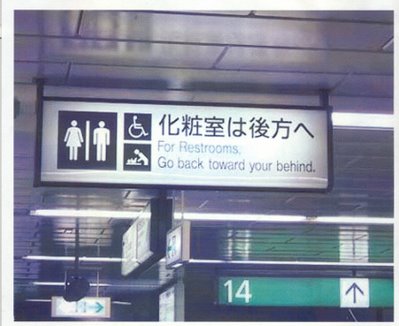
For those of who with weak constitutions, or who take offense at discussions of your bodily functions and the facilities designed to contain them, please tune out now.
(Here's where I can pretend that my mom has stopped reading, so I can widen the filter.)
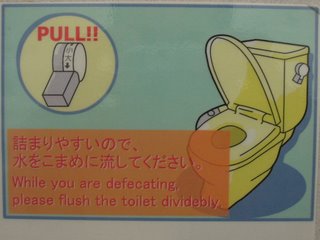
...dividebly?
***
The Japanese toilet is in a transitional phase, so this is a work in progress. We are right on the cusp between two eras. Japanese historians will look back and recognize these days for the ground-breaking revolution that they are, similar to when the Edo Period became the Meiji.
Let’s start by talking about technology in Japan. Yes, they are high-tech. Given. But they are more selective than Americans as to what technology they will embrace, and what they will delay on. Newer is not always better in Japan, so people hold on to what they have a little longer. Case in point, VHS still exists here. As does Mini disc. And let’s face it, chopsticks. They have known about forks and knives for generations now, and they are just fine with what they have. Sure, forks and spoons are used by kids before they learn to manipulate sticks, but sticks are still king. (From comedian Adam Corrola: 'And you should see the Japanese construction crew digging a ditch by using a couple of pool cues. Very impressive.')
Now, on to toilets. The traditional Japanese toilet is not much more than a ceramic hole in the ground. There is no seat. I call it a squatter. Pictured here from a centuies-old building at the Meiji Mura historical village, but this configuration is in many modern buildings, inlcuding my office though not quite as ornate.
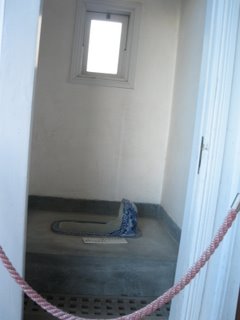
Closer look?
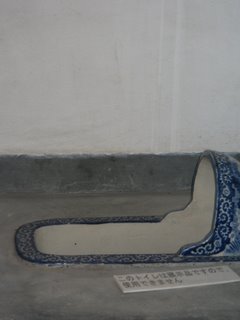
How does one use it? Instead of a thousand words, here’s a picture. My Japanese language study book has a cultural awareness page in every chapter. This image was in chapter number 8, but you'd think it'd be in number 2. (Click to enlarge.)
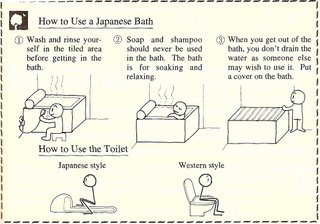
I include the bathtub usage instructions for comparison. The bathtub description gets 3 paragraphs. Toilet usage? Nary a word of instruction, and believe me there's more to it than knowing which way to face. Honestly that's a fairly minor point. A lot more could go horribly wrong with the toilet usage than with the bath usage. You use soap in the bath then drain it? Bit of a faux pas, but you're a foreigner, they'll understand. I'll let you imagine the outcome of toilet misuse.
I also like that they put the western style toilet in there for your reference, in case you forgot. Why doesn't the bathtub description doesn't have an image of the stick figure using a sudsy bath at home for reference?
One thing that's right on the money is they got the typical Japanese body type correct. Stick figure drawing must have been invented in Japan, because it's just so darn realistic.
Okay, back on topic.
In this Japanese culture that honors The Clean, if you were accustomed to that potty would you switch it up and prefer to sit on a regular western-style throne seat? Probably not. Benefit to the western-style: relaxing seat. Detriment: Kinda germy to share a seat with the world. So the Japanese as a society did not embrace the western throne because it did not honor The Clean. “Better safe than sorry” applied.
For the longest time there were only Japanese squatter-potties. In some places, where westerners frequent like my office, there was the occasional western potty. We all knew where they were and prefered to wait in line for them rather than taking our chances with the squatter. Our fear of the squatter might not need to be explained. Let’s just say that body parts and clothes are closer to the action than westerners are used to, so it makes us nervous. That and (except when drunk or Elvis) we've never had to worry about our balance while using the potty. So “better safe than sorry” applies for us as well.
The Japanese had their potty, the westerners had theirs. It looked like it would go the way of the chopsticks vs. forks and knives. Each side was happy with what they had.
But now the stalemate has been broken. (This revolution will not be televised, thankfully.) There have been technological advances to the western potty seats in Japan over the last 10-15 years. The primary component is the built-in bidet in the potty. Push a button and a little nozzle comes out below to spray your hind quarters clean. This technological advance has put The Clean back into potty-sitting, and the Japanese have now embraced it. The bidet has also put The Cheap into throne sitting, as paper is expensive.
The built-in bidet is where it started, but the Japanese spirit of ‘copy-and-improve’ has been in full force in the past decade. Once you’ve decided that electricity and buttons will be present, you can just start adding things.
Our own toilet seats in our home here have the following features: Seat warmer, bidet of adjustable water temperature, spray strength and optional oscillation, air deodorizer, auto flush sensor activated when you stand, and pushbutton controls (including two flush buttons, ‘small’ and 'big'- translated #1 and #2) on a wall-mounted console next to the seat. Other versions include a auto lid lifter when you approac. Ours might have other features, but I only push the buttons I'm familiar with.
Our wall mounted controls for the "Toilet of Wonder".
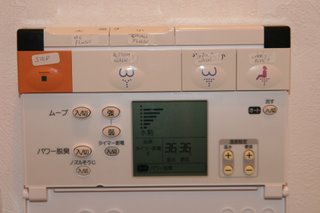
The Simpsons in Japan episode was not too far off. When Homer approached the hotel’s toilet it put on a water and light show and announced, “I am honored to accept your waste.”
From what I hear, the auto-powder feature, the splash suppressor, the built-in Brazilian waxing, and the computer generated voice giving words of encouragement will be the next steps. The auto colonoscopy is still a ways off, however.
And now the original concern about The Clean (sharing a seat with strangers) has also been addressed. It’s getting more common to have sanitizing gel dispensers in the stalls. Put a little on a tissue, wipe down the seat, and you are sparkling.
The potty revolution has not been complete. There is still a generational difference, I think. Luddites who would prefer to squat rather than to sit on a robotic fountain are still around. The age of a building often determines what potty specification you’ll find there. My own office has low-tech and high-tech in neighboring stalls. Tradition and technology side by side. It's an allegory of Japan itself.
Toilets have always been a topic of conversation for the western traveler in Japan. It used to be shock and surprise at the primitive facilities. Now it’s shock and surprise at the elaborate technology. Yet another way the Japanese are superior.
Side note 1. Warning for men using the fully modern Japanese restroom. There are buttons on the wall, and most of us can’t read them. If you are someone who, like me, occasionally stands up in front of the potty, take care which button you press. When trying to flush, if you press the wrong button the bidet feature will engage, and begin spraying up out of the bowl. The arc of the stream will almost exactly match the arc which you created just moments before, and will stike you right where it counts. It won’t hurt, but as you exit, people will think you didn’t make it in there in time.
****
Side note 2. Public Service Announcement: If you are someone who, like me, occasionally wears pants, the toilet usage instruction sketch above has a key component missing: pants. The #1 rule: Western toilet, pants at ankles. Japanese toilet: Pants at knees. If this had been a real PSA, I would have come up with a clever rhyme or jingle and maybe a spokespuppet. You know, for kids. But I believe further explanation isn't required.
****
Side note 3. Potty talk. If you are traveling in Japan and nature calls, don’t ask someone where the bathroom is. Let me remind you that Japanese like a nice soak in a hot bath. They take baths, and even do have shared public bathing areas, or Bath Rooms. However, bathroom is not a word for restroom in Japan. This is an actual conversation that happened when two colleagues of mine, one Japanese and one American, landed at the airport in Japan:
American: Hey, where’s the nearest bathroom.
Japanese: The what?
American: The bathroom. I need to use the bathroom.
Japanese: Um, I don’t think there’s one in the airport, and anyway we don’t have time for that now.
So please use the word ‘Toilet’. They’ll know what you’re talking about.
***
“Vision without action is a daydream. Action without vision is a nightmare.”
(Japanese Proverb)
***






















